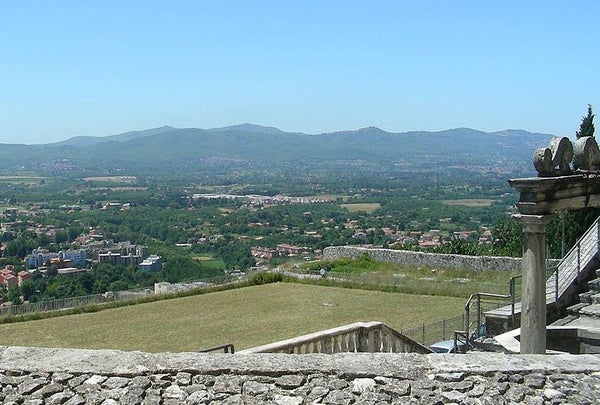Italy is a hotspot for hazardous volcanoes. As the crust of Africa’s tectonic plate burrows beneath that of Eurasia, magma rises from below, leading to nearly a dozen explosive mountains throughout the country. Vesuvius and Etna are the most infamous. But Colli Albani—a volcanic complex of hills some 30 kilometers outside Rome—has been a hidden threat. It seemed extinct because through all human history there was no clear record that it had erupted. Then in the 1990s scientists noticed that the hills were rising and an earthquake swarm shook the ground. Puffs of carbon dioxide seeped out of cracks in the hillside and silently killed roaming animals. Scientists started to dig further—literally—and found evidence that 11 eruptions had occurred over the last 600,000 years, proving the volcano was not extinct but dormant.
In a new study published in Geophysical Research Letters, Fabrizio Marra of Italy’s National Institute of Geophysics and Volcanology and his colleagues suggest that Colli Albani is now waking from a long slumber. Because of Rome’s close proximity and the number of towns in the hills—the Pope’s summer residence in Castel Gondolfo among them—the possibility has drawn scientists in for a closer look, and has triggered a debate over the volcano’s near-term danger.
Marra’s team collected samples of ash and lava from six past eruptions over the last 365,000 years and shipped them to Brian Jicha, a geochronologist at the University of Wisconsin–Madison, who dated the samples in his lab using the rate of decay of radioactive isotopes in the material as a kind of atomic clock. Jicha’s dates suggest that the eruptions happen at fairly regular intervals, and the most recent series occurred about every 31,000 years during the last 100,000 years. But the last one was 36,000 years ago. “The quiescent time has overrun the recurrence time of 31,000 years, a fact that indicates that the volcanic system is ready for a new eruption,” Marra says.
On supporting science journalism
If you're enjoying this article, consider supporting our award-winning journalism by subscribing. By purchasing a subscription you are helping to ensure the future of impactful stories about the discoveries and ideas shaping our world today.
The system appears overdue. But that alone does not suggest that the volcano is entering a new eruptive phase. Marra’s team points to a number of other indicators. In particular, new satellite data and geologic evidence revealed ongoing inflation—the hills have swelled by 50 meters over the last 200,000 years—which is likely caused by magma slowly seeping toward the surface. Previous research also hinted at this uplift but scientists did not know if that uplift was short-lived or continuing. “It's pretty clear that this is not a system that you can call inactive,” says Alberto Malinverno, a geologist from Columbia University who was not involved with the research. “It seems to have these spurts of activity over timescales that are long for human beings, but it's there.”
Marra and his colleagues think the regular cycle of Colli Albani’s eruptions can be explained by changes in the region’s crust. Throughout the volcano’s quiescent time the land above was being pushed together by the surrounding geology, keeping the magma bubble sealed. But the pressure within the magma chamber built until it could overcome the compressive strength of the land above. Marra’s data suggest that this transition occurred in the last few thousand years. “It’s like you’re baking a cake and a bubble develops in the cake,” Malinverno says. “You can see that the crust in the surface at some point is going to split.” It has likely already started to open new pathways that will eventually allow magma to breach the surface. The volcano will erupt, the system will settle down, return to its sealed state and the cycle will begin again.
Whereas Marra’s data suggests that the system is currently refilling its magma chambers, it still takes thousands of years to lead to an eruption, Marra cautions. “It is important to say that there is no sign at the moment that an eruption could happen soon,” he says. “For at least 1,000 to 2,000 years, such an event is very unlikely.”
Adding to the uncertainty, not every scientist agrees that the volcano is entering an eruptive phase. Quiescent volcanoes, argues Guido Giordano, a geologist at Roma Tre University who was not involved in the research, can show similar signs of volcanic unrest. Even without new magma infiltrating the system, the old magma (even as it cools) continues to heat the ground above, leading to carbon dioxide release, seismic swarms and ground deformation. “If we have evidence—for example something geophysical—that suggests that something has changed, we have to cross-check that evidence with other evidence—for example something geochemical—before we can reach the conclusion that there is evidence of unrest, meaning input of new magma that may increase the level of hazards,” he says. “That's the bottom line.” Giordano sees no other evidence of new magma entering the system, which suggests to him Colli Albani is dormant.
Although Marra and Giordano disagree about the current state of the volcano, both say it is unstable and characterized by many well-known hazards, so scientists need to watch it closely. “I think the most important conclusion is not to go into a panic about the future of Rome but that this is an area that we need to keep tabs on and monitor with care,” Malinverno says.
